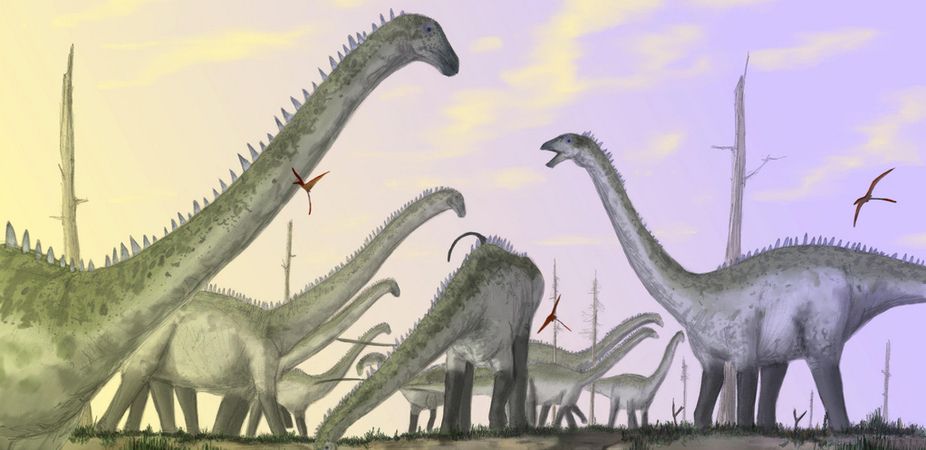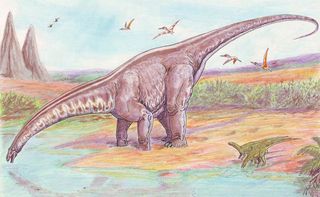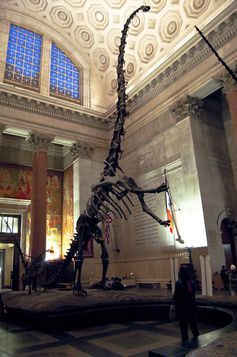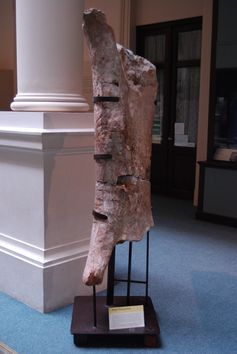
Necks Question ... How Did The Biggest Dinosaurs Get So Big? (Op-Ed)

This article was originally published at The Conversation. The publication contributed the article to LiveScience's Expert Voices: Op-Ed & Insights.
Alongside Tyrannosaurus rex, the basic sauropod dinosaur is one of the most iconic and instantly recognisable of prehistoric animals. Not only is their elegant shape with four columnar limbs, a long muscular tail and a hugely long neck with a relatively tiny head perched atop very well known, so is their prodigious size.
At masses that were equivalent to those of large baleen whales (about 85 tons), the largest sauropods were far and away the largest land-living animals that have ever lived. This of course prompts the obvious question:
why did they get so big?
Today saw the release of a collection of 14 papers under the banner Sauropod gigantism: A cross-disciplinary approach and published in the online open access journal PLOS ONE.
Many theories have been suggested, running to the wildly fanciful and improbable such as proposals that the Earth’s gravity was lower in the Mesozoic Era (around 252 to 66 million years ago).
Somewhat puzzling then is the paucity of proper scientific study that these magnificent beasts have attracted in the past. Why this might be so is not clear; perhaps it is partly to do with the sheer difficulty and expense of extracting and dealing with such large yet exceedingly fragile fossil bones.
Whatever the reason for past neglect, the tide has definitely been turning in the past decade or so. In particular, we have a major collaborative research unit, funded by the German federal government, looking into sauropod biology and in particular the evolution of their gigantism.
Sign up for the Live Science daily newsletter now
Get the world’s most fascinating discoveries delivered straight to your inbox.
Headed up by Professor Martin Sander at Bonn University, the unit includes 13 working groups from several different disciplines in science. So far they have published well over hundred papers and a comprehensive book summarising their work on the biology of sauropod dinosaurs - and today, add these 14 new papers to the literature.
This collection adds new research into several aspects of sauropod biology and takes a look at how the unit’s overarching model for the evolution of sauropod gigantism is faring with continued testing and investigation, from both within and without of the research unit.

Evolutionary cascades
At the heart of the research unit’s effort lies the “Evolutionary Cascade Model”, or ECM for short. This model posits that it was the sauropod ancestor’s unique mix of primitive and derived life history, physiological and functional anatomic traits that led to several evolutionary cascades of changes, that fuelled by positive feedback loops, that drove sauropod body size up beyond that of any other terrestrial animal group.
What is this proposed mix of traits? Put simply: a high basal metabolic rate and bird-style respiratory system including unidirectional airflow through the lungs (derived traits) combined with the production of many small offspring and very limited oral processing of food (primitive traits).
These traits are then hypothesised to have initiated five interrelated evolutionary cascades:
- reproduction
- feeding
- head and neck
- birdlike lung
- metabolism.
To look at how just one these cascades might work, let’s look at the feeding cascade.

If we start with the primitive trait of little to no chewing of food (and I should add at this point sauropods were undoubted strict herbivores) early sauropods needed little time between the acquisition of the food and swallowing it, which meant that they could have a high food intake rate.
Indeed through the evolution of sauropods we see the evolution of several specialisations to support increased food intake rates such as very fast tooth replacement, widening gaps through broader jaws and loss of cheeks.
This produced a selective advantage of obtaining more energy from the environment, provided that there was a larger gut capacity to deal with the high input of poorly chewed food, and selecting for larger body size.
Tiny head, long neck
To show how different cascades were linked we can see that the feeding cascade was also intimately linked to the head/neck anatomy cascade. The lack of oral processing of the food meant that the head did not have to carry a massive set of chewing muscles to deal with the increased load of plant fodder.

In modern mammals, chewing muscles and the heads that have to support them have to grow larger relative to body size as absolute body size increases. Thus free from this constraint, sauropods were able to evolve relatively small heads that required far less energy to carry and to move around, thus allowing necks to elongate and feeding envelopes - the amount of food (“browse”) that an animal can reach without having to walk - to increase.
By swinging their tiny head around on a very long neck, a huge amount of browse is available at little energetic cost, allowing the evolution of faster food intake rates, larger guts and larger body mass.
This is just one cascade chain in model that contains four others. In effect what the unit is proposing is a particularly complicated version of “correlated progression”, a model that has been proposed to explain a number of major transformations in macroevolution such as the origin of turtles and mammals. In correlated progression many traits are interrelated and evolution progresses by small changes in all of them occurring side by side in parallel.
Neck angle
So has a unified, monolithic picture of sauropod biology emerged? Not quite.
It is interesting to see that even within this collection there is still dissention between various researchers on the question of just how those immensely long necks of sauropods were deployed.
One contribution argues strongly that all sauropods held their necks straight out in front of their bodies in a horizontal, or near-horizontal pose.

These conclusions are based largely on digital models of the skeleton where each bone is articulated with its neighbours and manipulated so that the joint facets are minimally or maximally overlapping. This yields both a total range-of-motion (ROM) and something known as the osteologically neutral position (ONP), where the joint surfaces are maximally overlapped and the bones fit together most “comfortably”.
The researchers finds that the ONP has the sauropods neck sticking straight out, rather than raised up in a swan-like curve, and that the ROM does not allow the head to be lifted very far in the vertical plane although it does allow for wide lateral sweeps of the neck.
This would imply that despite their superficially giraffe-like necks no sauropods were committed high browsers.
Not so fast, says a different paper, which argues that the ONP tells us nothing about the typical attitude that the neck was held in life and that these skeletal models fail to take in the effect that soft tissues such as joint cartilages and intervertebral discs would have had on both the ROM and the ONP.
Huge body mass
Central to the issue of sauropod gigantism is body mass, which is a surprisingly difficult thing to measure in extinct, incompletely known animals.
Many estimates for different sauropods have been published using different methods and results have varied wildly even those based upon the same specimen.
In this collection of papers there is an attempt to estimate of one of the largest of all known sauropods: Argentinasaurus (see the video below).
The method used was to scan in the complete skeleton and in the computer construct “convex hulls”, which are simpler three-dimensional shapes that enclose major regions of the skeleton.
From these an estimate for the volume of the animal can be made and from that an estimate of mass. The technique has been applied to animals of known masses with good results so the estimate of 85 metric tons for Argentinasaurus may not be too far off the mark.
However, it is worth remembering that much the scanned skeleton that the convex hulls were built around was itself modelled from scaled-up remains of types of related sauropods because the original remains of Argentinasaurus are so incomplete.

This is a persistent problem in trying to discover the upper limits of mass that sauropods reached: all of the supergiant sauropod remains that have been found so far are frustratingly incomplete. Some of the researchers suggest a way out of this problem - rather than trying to estimate volume, and subsequently mass, from what is left of their dead remains, why not try to estimate the force applied to the ground when they walked and thus calculate mass in that manner?
Put very crudely the deeper the print, the heavier the trackmaker. Unlike skeletons, the footprints of supergiant sauropods are moderately well-represented in the fossil record, and trying that method with footprints left by elephants of known weight gets good results.
However, the researchers do not yet take the next step and apply their method to fossil sauropod prints. For the method to work properly, the physical properties of the substrate, and how it deforms when a heavy animal steps on it, must be known precisely. I suspect that estimating these properties for substrates that have been compacted and lithified by geological processes will present a great challenge - but I look forward to seeing future attempts.
There is a lot more contained in these papers that I haven’t discussed here. What is clear is that sauropods are fascinating and extreme examples of biological engineering. We have made big inroads into understanding how they worked as living organisms and how they got to be that way.
Yet there remains much left to be discovered and these awesome beasts from Earth’s past will keep scientists of all sorts busy for many years to come.
Adam Yates does not work for, consult to, own shares in or receive funding from any company or organisation that would benefit from this article, and has no relevant affiliations.
This article was originally published at The Conversation. Read the original article. The views expressed are those of the author and do not necessarily reflect the views of the publisher. This version of the article was originally published on LiveScience.












